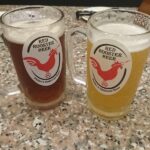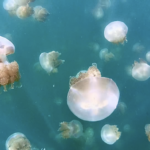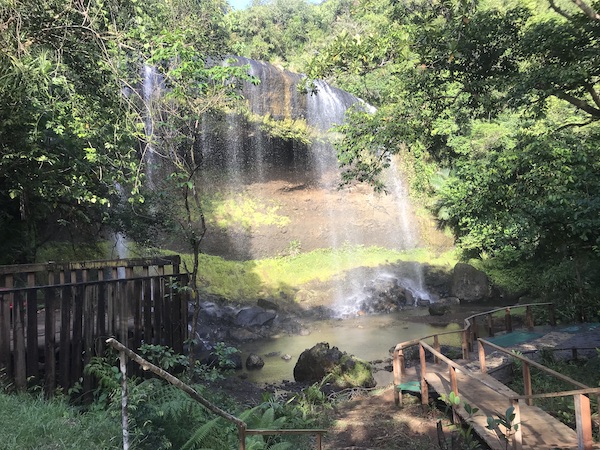Palau
Palau is an independent republic since 1990, located in the Micronesia area of Oceania. The archipelagos consist of more than 300 islands, the most known is Koror, due to its international airport, and the biggest island is Babeldaob, which is connected to Koror by a bridge. Only eleven of the islands are actually inhabited.
The dominant religion in Palau is mostly Christianity (90%). Official languages are English, Palauan and Japanese.
The biggest city in Palau and the main economic center is Koror. In Koror lives most of the nation, almost 12.000 people. Total population of Palau is only around 18.000 people. The capital is Ngerulmud, on the main island of Babeldaob, but there is not a lot to do, comparing to Koror. Population of around 300 people makes it one of the worlds smallest capital by population. The capitol building is really massive, comparing to other buildings on the island, and it was reported, that the building and maintenance had put Palau in debt. Interestingly as a part of cost-cutting actions, followed by the debt, was closing the Ngerulmud’s post office. The only open post office, that is still open, is in Koror.
Palau doesn’t have a military force of its own, but it is well protected by the USA.
Palau is also one of the least visited islands in the world. In 2017 Palau visited only 123.000 visitors. For comparison, number one was France with 87 million visitors.
In order to maintain tourism sustainable, they crated a numbers of permits for visitors. Every visitors must sign the ‘Palau Pledge’ , where he commits to preserve and protect the island
Palau Pledge:
Children of Palau, I take pledge as your guest,
to preserve and protect your beautiful and unique island home.
I wow to tread lightly, act kindly and explore mindfully.
I shall not take what is not given.
I shall not harm what does not harm me.
The only footprints I shall leave are those that will wash away.
Passport must be valid at least 6 months at the time of entry and it must have at least one full page available for the Palau Pledge.
Palau is also the land of permits and fees. All visitors must purchase a permit depending on the activity and places to visit.
- Environmental fee : 100 USD
*international airlines are required to include this fee into the ticket.
- Peleliu State permit: 15 USD for sightseeing, 10 USD for snorkelling and 30 USD for diving.
- Rock Island permit: 50 USD per person, valid for 10 days. It is needed for any ocean activity in Koror State. Activities include diving, snorkelling, kayaking, etc. (fishing and Jellyfish Lake are not included).
- Rock Island permit with Jellyfish Lake permit included: 100 USD per person, valid for 10 days.
Driving is on the right side of the road, however, most cars in Palau are right-side drive, as they are Japanese imports. It is a bit unusual combination.
The national speed limit is 40 km/h (25mph) and passing slow vehicles is illegal.
Rental cars are available upon arriving at the Palau International Airport or at a various offices in downtown Koror. We rented it from our hotel and returned it the next day at the airport. We payed 60 USD.
Unmetered taxis are the only mode of public transportation available. Prices for short rides are between 5-10 USD.
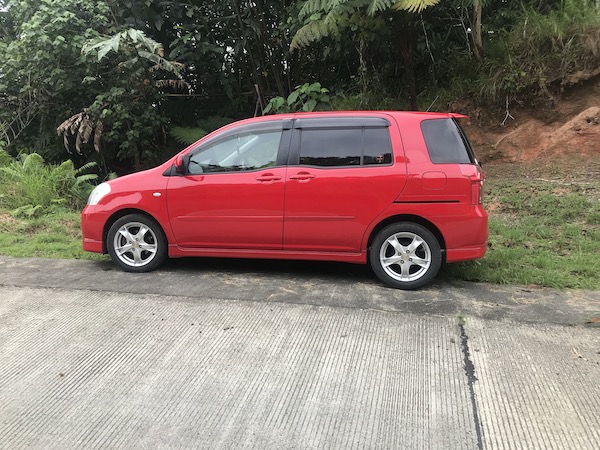
Rent a car – 60 USD per day

The view from The Japanese Lighthouse
Finding a public beach on this beautiful island is not as easy as one might imagine. There is only few beaches, that are suitable for swimming. Firstly, in Palau people do not sunbath topless or nude. Also bikini is not appropriate. I would recommend shorts and a rash guard. Usually access to a public beach is charged and it costs between 5 to 10 USD. Palau is great for divers, but not for travellers, who are seeking tropical postcard beaches. Public beaches do their job, but they are not really nice. On the other hand, resorts with gorgeous private beaches are super expensive, starting from 300 USD per night.
- Palau is safe, but in Koror State, where most tourist facilities are located, is a curfew between 2:30 a.m. and 5:00 a.m., Monday through Thursday, and between 4:00 a.m. and 6:00 a.m., Friday to Sunday, and on national holidays.
- Night life is more or less non existent. Palau night life means to go out for a dinner, listen to live music and have some cocktails and beers.
- Currency is American Dollar and also prices in bars and restaurants could easily compare to American touristic areas.
- Alcohol age limit is 21 years. Alcohol is not allowed in public areas.
- In Palau they have siesta. Most of bars and restaurants are closed between 14. and 17.00 pm.
- there are bidding salt water crocodiles hidden in the mangroves in Peleliu. They are rare, but it still makes sense to ask locals where it is safe to swim. The last attack was in 2012, when the swimmer didn’t saw the crocodile and bump into him while swimming. They both survived without any severe damage. No matter where you swim, it is hard to avoid the feeling of having crocodile nearby. The size of Peleliu island is only 13 square metres.
- make sure you have enough cash with you, when going to Peleliu or smaller islands. Cards usually don’t work or are not accepted. Even in hotels.
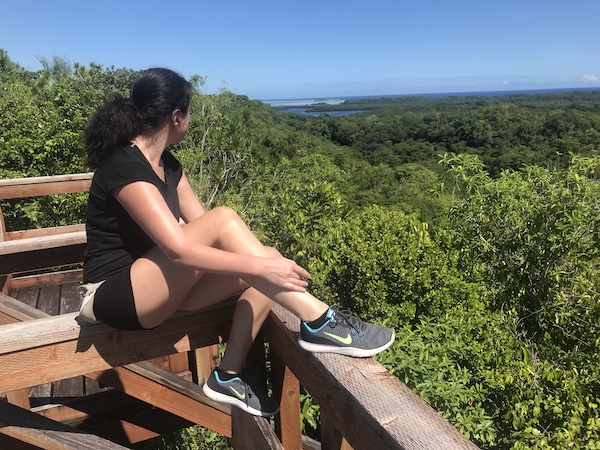
Gorgeus view in Peleliu island
1. Travel adapters
All power sockets in Palau provide a standard voltage of 120V with a standard frequency of 60Hz.
2. Motion Sickness Medicine
Prevention is better than a cure. Sea can be quite rough, and everyone who plans to go on a boat trip, and has problems with seasickness, should consider taking the medicine. Although, in December, when we visited, the sea was really smooth.
3. Dry Bags
Dry bags are essential if you’re going on a snorkeling or diving trips. Pack a small dry bag inside your daypack for boat trips or use a waterproof phone case to keep your phone and other gadgets dry.
4. Underwater Camera
The world down there is amazing, and make sure to bring home some fantastic memories. But remember, touching marine life is a big no-no for all divers and while you can bring home some nice photos, please leave everything else in the ocean. Except for trash. It is ok to bring the trash out.
5. Sunscreen
Bring lots of sunscreens, and make sure it has double protection. It should protect both your skin and the reefs. Palau is the first country to ban reef toxic sunscreen, so make sure you have the right sunscreen with you.
6. Sunglasses
Protect those beautiful eyes with a nice pair of sunglasses. They are not only stylish but they also prevent sun-related health problems, like glaucoma, skin cancer around the eyes, migraines, and they give you a better vision. A big plus is also that you can stare if you want to. Nobody will know…
7. Sun Hat
Enjoy those sun-soaked days and protect yourself from the heat. And wrinkles. We do not want wrinkles…
8. Snorkeling Gear
Snorkeling gear is personal, especially a mask. And mask clearing sometimes requires questionable treatment. 
Fins are also important. I cannot imagine using anyone else’s. They must fit perfectly and give good lift and control over every move.
9. Swimwear
‘If it requires a bikini, my answer is yes.’ When it comes to swimwear, more is less. And those little pieces don’t take too much space in the suitcase anyway. Do not listen to your other half telling otherwise.
10. Summer and beach dresses.
11. People of Palau are dressed really modestly, so the same is recommended for visitors. Visitors should cover shoulders and knees.
12. Shoes
All you need is flip flops and diving shoes.
13. Shorty
We used 3 mm shorty for diving and it was perfect. Water is warm even at 30 m.
14. UV Protection Clothing
Not only it protects from sunburns but also reduces the amount of used sunscreen. In Palau it is also common to swim in a t-shirt and shorts on a public beach.
1. Narcotics and psychotropic substances.
Possession of drugs can result in imprisonment.
2. Liquor
It is allowed to import up to two liters of alcohol.
3. Cigarettes
It is allowed to import up to 200 cigarettes.
4. Reef Toxic Sunscreen
Palau is the first country to ban reef toxic sunscreen, so make sure you have the right sunscreen with you. It cannot contain any of the following:
- oxybenzone (benzophenone-3);
- octinoxate (octyl methoxycinnamate);
- octocrylene;
- 4-methyl-benzylidene camphor;
- triclosan;
- methyl paraben;
- ethyl paraben;
- butyl paraben;
- benzyl paraben;
- phenoxyethanol.
Importation and distribution of ‘reef toxic’ sunscreens will carry fines up to USD 1,000.
5. It’s illegal to disturb or take historical items, including the ones from the sunken vessels.
There is a lot of other items. I just listed the ones, that I found interesting and are more commonly found in the average suitcase.
This tropical paradise can be visited all year round. Temperature is between 23 and 32 degrees. High season is from December to March, when there is the least rain and the sea is calm. Low season is from June to August, when there is heavy rainfall with winds. Months in between, are shoulder season, which means some dive sites might not be accessible and the sea can get choppy.
Water temperatures are very stable all year round, averaging between 28 and 30 degrees Celsius. Visibility can excess 40m, but it drops to 15 – 20 meters, between June to September.
Most marine life can be seen all year round, but some are more likely to be seen in specific time frame.
- Whale Shark: January to April
- Mata Rays: January to April
- Turtles: April to July
- all year round: Blacktip and Whitetip sharks, dolphins, hammerhead sharks, eagle rays, Napoleon wrasse etc.
The ones reading my previous posts already know, that I really hate to spend more time on the dive boat than needed. So we decided to stay most of the time on Peleliu Island, since it is the closest to the most known dive sites. Most of the dive sites were within 10 to 20 minutes of boat reach. We usually arrived at the most popular dive sites ahead of the boats from Koror. I would like to add here, that the most of the WWII wreck dives are closer to Koror than Peleliu. We wanted to do some dives on the wreck, but I didn’t do the proper research, and just assumed the wrecks are closer to Peleliu, since the battle was mostly on Peleliu Island. In reality, all WWII wreck dives are from Koror and mostly for Advance Divers with wreckage diving experience.
We flew to Palau with China Airlines from Taipei and arrived in the afternoon to Palau International Airport. We prearranged our taxi with a hotel, which cost us 15 USD. Due to the late arrival, we spend our first night in West Plaza Hotel at Lebuu Street. Hotel is new, located in the city center. They opened it in 2019. The rooms are beautifully equipped and very comfortable. Our room was in a higher floor, with a stunning view of the ocean. I am adding video below.
First evening we went for a stroll in the city and ended the evening with a dinner in the hotel restaurant Red Rooster Cafe. The cafe is also popular among locals, and they serve local Red Rooster draft beer, which we wanted to try. Food was good, but we weren’t so much into the food. We were more interested in the local beer. The next morning we took a tour around Rock Islands with snorkelling in Milky Way and finishing with lunch on a beautiful Carp Island. We haven’t return with the group, since we had arranged with our hotel Dolphin Bay Resort Peleliu, to pick us up on the Carp Island by boat and transfer us to Peleliu. After reaching the resort we had short briefing and planned our dives. On Peleliu, we stayed 6 nights. One day we rented a bike and did the tour of Peleliu by ourselves and the other five days we were diving. We returned to Koror by a local ferry and spent there two more nights.
Rock Islands
Rock Islands is Palauan pride under the UNESCO protection. There is no need to plan to see it in advance, because you’ll run into these islands anytime you do something involving Palau’s water. So if you choose a tour, choose a tour to Jellyfish Lake or to a Carp Island.
We did our dives with Peleliu Divers, which are based in the Dolphins Bay Resort Peleliu. As usual we picked our hotel based on recommended dive shops. Usually we do it, because we like our easy mornings, knowing the dive shop is just few steps away. But in this case, it was actually really good decision. Peleliu Divers is a very busy shop and guest of Dolphins Bay Resort have a guarantee spot with Peleliu divers, while divers staying in others resort might have problems getting on the boat, since there is a limited space, with a maximum of ten divers. There was a couple diving with us, who stayed in a local B&B. They said they always need to confirm, a day before, if there is a spot on the boat, and a few times they were not able to dive, because guests from the Dolphins Bay Hotel filled the boat. Peleliu divers do the classical ‘valet’ thing. They do everything for you. Bring equipment to the boat, set it up and also clean it afterwards. It is also absolutely fine to deny the service. On the boat, the team of Peleliu Divers provides everyone with water or juice and fresh coco. Both dives are done in the morning and after dives, we always had lunch on some of the beautiful and known beaches, like Long Beach for example.
My favourite dive spot was Virgin Blue Hole. It starts in really shallow reef with a relatively small hole. Divers descend down the hole, which is like a tunnel going downwards, to the depth of 30 m. At the bottom, there is a tunnel exit to the open sea, but due to the lack of light, the torch is needed. Once out of the tunnel it is the most beautiful moment. When looking up, sharks can be seen cruising above in the shallower water. It is a spectacular view. Sometimes there is also the rare leopard shark sleeping at the bottom.
One of the most popular spots is also German Channel. We did only one dive, but I cannot really say I enjoyed it. It was a fierce current.
We rolled backwards into the water and already after few minutes, we could feel the current. We did have the current hooks, but it was still very challenging. German Channel is known for Manta Rays, and we saw five of them swimming together leisurely. Mantas made the dive worth it, but otherwise I do not remember a lot, except for fighting the current.
Blue Corner is another spot not to be missed. It is the most famous dive site in all of Palau. I remember it mostly by sharks. There was a lot of Bull Sharks.
Big Drop Off was really fun. The reef wall on one side, the breathtaking deep blue on the other – on the vertically sloping wall you can let yourself be relaxed as a diver and marvel at the beautiful underwater world. We were drifting slowly along the wall, looking at corals and large school of tropical fish. Looking into the blue, we could see sharks cruising around. We also saw the black and white banded sea snake (Mengerenger). Snake is highly venomous, but not aggressive. Our dive master wasn’t so happy to see it, since it was right behind him and he didn’t saw it. We were trying to get his attention by pointing at it, and he manage to avoid the last minute collision. Back then I didn’t know it was poisonous, but I kinda assumed, by the way our dive master swam away very quickly.
Peleliu Wall is another beautiful place, full of turtles and sharks and big school of tropical fish. If lucky, there might be also some dolphins. We saw them, while on the boat and they made spectacular show for us. Jumping from the water and spinning in the air.
We were extremely lucky on the January 1st, when we were the only ones to dive. We went out to Peleliu Walls and it was one of the most beautiful dives, with so many fishes, it looked like we were in aquarium.
We combined our visit to the Jellyfish Lake with our two dives, so we didn’t lose to much time. Jellyfish Lake is a marine lake in a Rock Island, known by a thousands of stingless jellyfish. It is not possible to scuba dive in the lake, due to high concentrations of hydrogen sulfide on the bottom and because bubbles could hurt the delicate jellyfish.
To get to the jellyfish lake, we needed to hike path up a steep hill, so water shoes are a must. I do not recommend flip flops, because it can get very slippery. Jellyfish usually follow the sun, so it is easy to find them on the sunny side of the lake. They are really delicate, so it is important to pay attention while snorkelling. Permit to Rock Islands, combined with Jellyfish Lake costs 100 USD. Transfer is not included in this cost.

Photobombed while posing
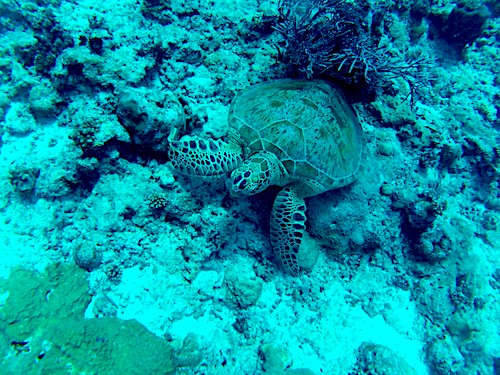
Turtle, Palau

Shark cruising above us
Since our trip to Palau was mostly about diving, we chose the resort as it was closer to most of the dive sites. We also liked the feel of a small boutique resort.The resort has only seven, all ocean-view bungalows. The property feels very secluded with lush vegetation all around. Room was nice and clean and we were lucky to get the last bungalow in the row, since we really like privacy. It is very quiet and we slept so well on the great beds. The staff was friendly. What I didn’t like so much, was the food. We had half board and the food was fine, but no culinary masterpiece. Food was more Japanese style, which is also reasonable, since a lot of guests comes from Japan.
Internet is a bit slow and they asked us to do all the payments in cash, which is a bit annoying. There is no ATM in Peleliu, so we needed to bring cash for our stay, diving and other extras from Koror. And we just didn’t feel good, carrying all this cash around.
In the hotel you can also rent kayaks and bikes (10 USD per day).
The Battle of Peleliu took place Peleliu island from September to November 1944. The battle was originally supposed to last only a few days, but in the end lasted almost three months. Although the battle was short, more than 11.000 Japanese and more than 1.000 US Marines died in this tropical island. Japanese were fiercely fighting Americans and although at the end Americans won, the victory was very bitter-sweet.
There is a lot of remnants of WWII on the island and there is a lot of official tours offered. We chose to do the sightseeing by ourselves, which totally made sense, since my partner is a walking history encyclopaedia. Peleliu has only 13 square kilometres in size and around 400 people live there. So we rented bikes from our hotel and decided to bike around the island. There was a big map of Peleliu at reception and we just took photo of it, so we knew where we are.
Our first stop was Japanese War Cemetery Kloulklubed, established by a Japanese survivor of the battle of Peleliu. Just a little bit ahead, you can find Memorial to Japanese War Victims and then almost next to it Bloody Nose Ridge Marine Memorial, which is dedicated to the marines of the 1st US Marine Division. Continuing our ride, we saw a lot of different rusty landing vehicles, tanks, caves that were used by Japanese, abandoned fighter jet etc. We stopped at a World War II Museum, which contains a very interesting exhibition about the Battle of Peleliu.
Next stop was Invasion Beach “Orange Beach” Peleliu, where the first US invasion forces came ashore on 15 September 1944. Nearby
you can also find the 81st Infantry Division Memorial, the place where memorial is standing, was used as a temporary grave during war.
We continued our way to the Peace Memorial Park, which is beautifully settled on the southwestern tip of the island. Here we realised that we probably didn’t bring enough water with us. We had just a little left and we haven’t seen any shop on our way, since we left the hotel. We needed to go back anyways, so we decided to continue to the other side of the island and to find the airfield. Peleliu is hot and humid so you have to be in the shape, even though the island is tiny. We found an airfield and an old rusty tank next to it. We continued to a Battle of Peleliu Jungle trail and started to walk. The trail has still not been cleared of Explosive Remnants of War, so it is important to stay within the markers. One of the trails led us to the viewing platform with 360 degrees panoramic views of Peleliu Island. The summit is marked with a “World Peace” stone. Here we already ran out of water and we were becoming really thirsty, so our next mission was to get to the north part, where all the shops are. We drove off, had some difficulties with bike, but somehow managed to get to the north. On the way we found piles of trash, it seemed a part of the island is used for that, which kinda looked bad. They are promoting eco tourism and taking care of the nature, and then there is a huge pile of unprotected trash, that can be anytime blown to the sea.
When we finally reached north part we went straight to the shop, bought some drinks and enjoyed the beach for a while. Afterwards we slowly returned to the hotel. I was a bit bothered by huge dogs that were walking around freely. During the day it felt safe, since they were lazy and it seemed they are not even interested in us. But I wouldn’t ride there alone in the evening.
We asked at reception for rent a car options. Since it was our last day, we wanted to pick up the car in the hotel and to drop it at the airport the next day. They said it was possible and it costs 60 USD, which we happily payed. In the car there was a map with the most important sights of the island with description. We had our tank full and enough water for a day, just in case there wouldn’t be any shops or gas stations. We learned our lesson in Peleliu. On Babeldaob is a nice road, that goes all around the island, so it is very easy to follow the map. Well, so it seemed. Our first stop should be Ngatpang Waterfall. We have read that it should be near the main road, but the path is not marked. We found the spot where it should be, but we couldn’t find the waterfall. To be honest, we weren’t even trying to much, because our main plan was to see the Ngardmau Waterfall. Well, we didn’t read a lot, we just saw a picture of a beautiful waterfall, that we wanted to see in person. We found the spot, payed the entrance fee of 10 USD per person and started walking towards the waterfall in the flip flops. There was a lot of stairs and walking in the water, and somewhere during the walk, we started to think about our water shoes, that we left in the trunk. Really good Scubapro water shoes, that are made for situations like this. Well we managed the little hike in flip flops, but I really recommend taking water shoes with you.
Our next stop was Badrulchau Stein-Monoliths, which are Palau’s largest and perhaps oldest megalithic site. We parked our car and pay the admission fee of 5 USD per person. There is a lot of stories regarding monoliths and their nature, but one of the more believable version is, that they are remains of the old community house. Monoliths are interesting but the view from the terraces is gorgeous. It is really worth visiting just for the beautiful view.
A bit further north we stopped at the now ruined Japanese Lighthouse. Entrance fee is 5 USD. There is not a lot left from the lighthouse but the view from there is even more spectacular.
After all the hiking we had a quick lunch at the M&A Eco-Beach Bungalows. They also have a private beach and the entrance fee is 10 USD per person. The beach is really nice though.
Our last stop was Palau National Capitol in Ngerulmud, Melekeok state. The building is huge and stunning. We expected more people around, but we were basically alone, so we were just wandering around the building and took some pictures.
On a way back to Koror we enjoyed the view of a Japan-Palau Friendship Bridge for a second time. The bridge that connects Koror to Babeldaob was built with significant Japanese Grant Aid, since the Palau government lacked sufficient funds to built a new bridge, after old one collapsed. We arrived in Koror exhausted, but happy. Our final day in Palau was fun and we thoroughly enjoyed it.
Palau is expensive, but it is a paradise. it is an ultimate destination for divers and also for nature lovers. I would not recommend it to travellers, that are seeking the tropical beaches and the tropical vacation vibes. For them, there are a lot of options in South East Asia, that are much less expensive than Palau. Palau is a jewel, but only for travellers who know how to appreciate it. Others might find it a bit boring. I would definitely visit again and I will if I have a chance.



